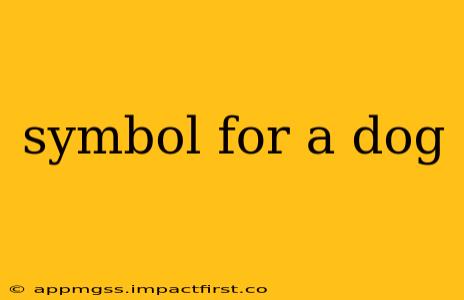Decoding the Canine Code: Understanding Dog Symbols
The symbol for a dog isn't a single, universally accepted character like some other animals. Instead, representation varies across cultures, contexts, and artistic styles. This makes understanding "the symbol for a dog" a multifaceted exploration. Let's unpack this by examining various ways dogs are symbolized.
What are some common ways dogs are represented symbolically?
This question delves into the richness of canine symbolism. Often, the representation depends on the specific breed or even the individual dog's role in a story or culture. However, some common visual symbols include:
-
Stylized Drawings: Simple line drawings, often found in children's books or as pictograms, frequently use a basic silhouette of a dog – four legs, a tail, and pointed ears. These are easily recognizable and widely understood.
-
Breed-Specific Imagery: Certain dog breeds have become strongly associated with specific imagery. For instance, the German Shepherd might be represented with a more serious, protective posture, while a playful Golden Retriever might be shown in a more energetic, bouncing pose.
-
Zodiac Symbols: While not a direct symbol, the dog features prominently in the Chinese zodiac, where it represents loyalty, honesty, and friendliness. The image used in this context will vary depending on the artistic style.
-
Mythological Representations: In various mythologies, dogs hold symbolic weight. Cerberus, the three-headed dog guarding the gates of Hades, is a prime example. He symbolizes the threshold between life and death and the challenges we face in the afterlife. Other cultures might depict dogs as guides to the spirit world or protectors of the home and family.
What symbol represents loyalty in dogs?
Loyalty is a frequently cited trait associated with dogs. There isn't one single symbol universally representing this, but certain images evoke the concept strongly. A dog depicted sitting patiently by its owner's side, or a stylized heart incorporating a dog's silhouette, are examples of imagery conveying this message. The context is key; the visual must be placed within a narrative or design that establishes the meaning.
What are some emojis or Unicode characters that represent a dog?
The digital world offers its own range of canine representations. Several emojis depict dogs, ranging from simple outlines to more detailed and breed-specific images. These vary by platform but usually include a generic dog face, paw prints, and occasionally specific breeds like a poodle or Shiba Inu. You can easily find these by searching "dog" in your emoji keyboard. Remember that the specific appearance can vary based on the operating system and the emoji font used.
How are dogs symbolized in different cultures?
Canine symbolism is richly diverse across cultures. In some cultures, dogs are viewed as sacred animals, while in others, they are associated with specific deities or spiritual beliefs. The interpretation can shift dramatically; what might be a symbol of good luck in one culture could be considered unlucky in another. Researching specific cultural interpretations will reveal the nuanced significance of dogs in various societies.
Are there any specific symbols related to guide dogs or service dogs?
While there isn't a single universally recognized symbol for guide or service dogs, the use of specific vests or harnesses clearly identifies these working animals. These highly visible accessories serve as an immediate visual cue, communicating the dog's vital role and the handler's need for assistance.
In conclusion, "the symbol for a dog" isn't a singular answer. The representation is highly context-dependent, ranging from simple drawings to complex cultural and mythological interpretations. Understanding the specific context and the intended message is vital to interpreting any given symbol representing a dog.
